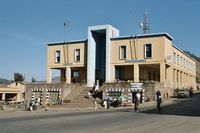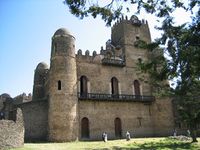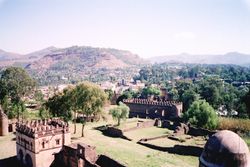گوندر
گوندر | |
|---|---|
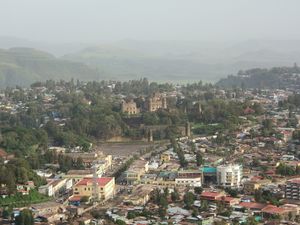 منظر المدينة ويتوسطه قلعة فاسيل | |
| الإحداثيات: 12°36′N 37°28′E / 12.600°N 37.467°E | |
| البلد | إثيوپيا |
| المنطقة | منطقة أمهرة |
| المقاطعة | مقاطعة سمين گوندر |
| المنسوب | 2٬133 m (6٬998 ft) |
| التعداد (2008) | |
| • الإجمالي | 231٬977 (est) |
| منطقة التوقيت | UTC+3 (EAT) |
گوندر Gondar أو Gonder (گعز: ጎንደር گوندر، وقبل ذلك ጐንደር Gʷandar، النطق المعاصر گوِندر Gʷender بكسر الواو) هي مدينة في إثيوبيا، وكانت في وقت ما العاصمة الامبراطورية وعاصمة اقليم بگمدر التاريخي. ونتيجة لذلك، فإن مقاطعة بگمدر القديمة أحيانا يـُطلق عليها گوندر. وتقع المدينة في مقاطعة سمين جوندر في منطقة أمهرة, وتقع جوندر شمال بحيرة تانا على نهر عنگريب الأصغر وجنوب غرب جبال سمين. إحداثيات المدينة هي 12°36′N 37°28′E / 12.600°N 37.467°E بارتفاع 2133 متر فوق سطح البحر.
التاريخ
Until the 16th century, the Solomonic Emperors of Ethiopia usually had no fixed capital, instead living in tents in temporary royal camps as they moved around their realms while their family, bodyguard and retinue devoured surplus crops and cut down nearby trees for firewood. One exception to this rule was Debre Berhan, founded by Zara Yaqob in 1456; Tegulet in Shewa was also essentially the capital during the first century of Solomonic rule.
Beginning with Emperor Menas in 1559, the rulers of Ethiopia began spending the rainy season near Lake Tana, often returning to the same location again and again. These encampments, which flourished as cities for a short time, include Emfraz, Ayba, Gorgora, and Dankaz.
Gondar was founded by Emperor Fasilides around the year 1635, and grew as an agricultural and market town. There was a superstition at the time that the capital's name should begin with the letter 'Gʷa' (modern pronunciation 'Gʷe'; Gonder was originally spelt Gʷandar), which also contributed to Gorgora's (founded as Gʷargʷara) growth in the centuries after 1600. Tradition also states that a buffalo led the Emperor Fasilides to a pool beside the Angereb, where an "old and venerable hermit" told the Emperor he would locate his capital there. Fasilides had the pool filled in and built his castle on that same site.[1] The emperor also built a total of seven churches; the first two, Fit Mikael and Fit Abbo, were built to end local epidemics. The five emperors who followed him also built their palaces in the town.
In 1668, as a result of a church council, the Emperor Yohannes I ordered that the inhabitants of Gondar be segregated by religion. This caused the Muslims to move into their own quarter, Islamge (Ge'ez: እስላምጌ "Islam place," or "Islam country") or Islam Bet (እስላም ቤት "House of Islam," lit. "Islam house"), within two years. This quarter came to be known as Addis Alem.[2]
During the seventeenth century, the city's population is estimated to have exceeded 60,000. Many of the buildings from this period survive, despite the turmoil of the eighteenth century. By the reign of Iyasu the Great, Gondar had acquired a sense of community identity; when the Emperor called upon the inhabitants to decamp and follow him on his campaign against the Oromo in Damot and Gojjam, as had the court and subjects of earlier emperors, they refused.[3] Although Gondar was by any definition a city, it was not a melting pot of diverse traditions, nor Ethiopia's window to the larger world, according to Donald Levine. "It served rather as an agent for the quickened development of the Amhara's own culture. And thus it became a focus of national pride... not as a hotbed of alien custom and immorality, as they often regard Addis Ababa today, but as the most perfect embodiment of their traditional values."[4] As Levine elaborates in a footnote, it was an orthogenetic pattern of development, as distinguished from an heterogenetic one.[5]
The town served as Ethiopia's capital until Tewodros II moved the Imperial capital to Magadala upon being crowned Emperor in 1855; the city was plundered and burnt in 1864, then devastated again in December, 1866.[6] عبد الله بن محمد sacked Gondar when he invaded Ethiopia June 1887. Gondar was ravaged again in 23 January in the next year, when the Sudanese invaders set fire to almost every one of the city's churches.[7]
بعد اخضاع إثيوبيا لمملكة إيطاليا في 1936، طـُوِّرت جوندر من قِبل الاحتلال الإيطالي.[8] During the Second World War, Italian forces made their last stand in Gondar in November 1941, after Addis Ababa fell to British forces six months before. The area of Gondar was one of the main centers of activity of Italian guerrilla against the British forces until summer 1943.[9]
أثناء الحرب الأهلية الإثيوبية، سيطرت قوات الاتحاد الديمقراطي الإثيوبي على أجزاء كبيرة من بگمدر، وخلال أوقات في 1977 وصلت لأميال قليلة من جوندر، وكانت على وشك السيطرة على جوندر.[10] As part of Operation Tewodros near the end of the Civil War, Gondar was captured by the Ethiopian People's Revolutionary Democratic Front in March 1991.[11]
المعالم
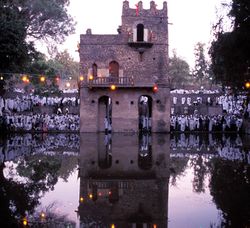
المدن الشقيقة
جوندر على شقاقة مع المدن التالية:
الهامش
- ^ Richard K.P. Pankhurst, History of Ethiopian Towns: From the Middle Ages to the Early Nineteenth Century (Wiesbaden: Franz Steiner Verlag, 1982), vol. 1 p. 117.
- ^ Solomon Getamun, History of the City of Gondar (Africa World Press, 2005), p. 16
- ^ Getamun, City of Gondar, p. 5
- ^ Donald N. Levine, Wax and Gold: Tradition and Innovation in Ethiopia Culture (Chicago: University Press, 1972), p. 42
- ^ Levine, Wax and Gold, p. 42 n. 42
- ^ Sven Rubenson, King of Kings: Tewodros of Ethiopia (Addis Ababa: Haile Selassie I University, 1966), pp.71f
- ^ "Local History in Ethiopia" (pdf) The Nordic Africa Institute website (accessed 9 May 2008)
- ^ Getamun, City of Gondar, pp. 28-37
- ^ Getamun, City of Gondar, pp. 55-60
- ^ Marina and David Ottaway, Ethiopia: Empire in Revolution (New York: Africana, 1978), p. 171
- ^ Paul B. Henze, Layers of Time: A History of Ethiopia (New York: Palgrave, 2000), p. 322

